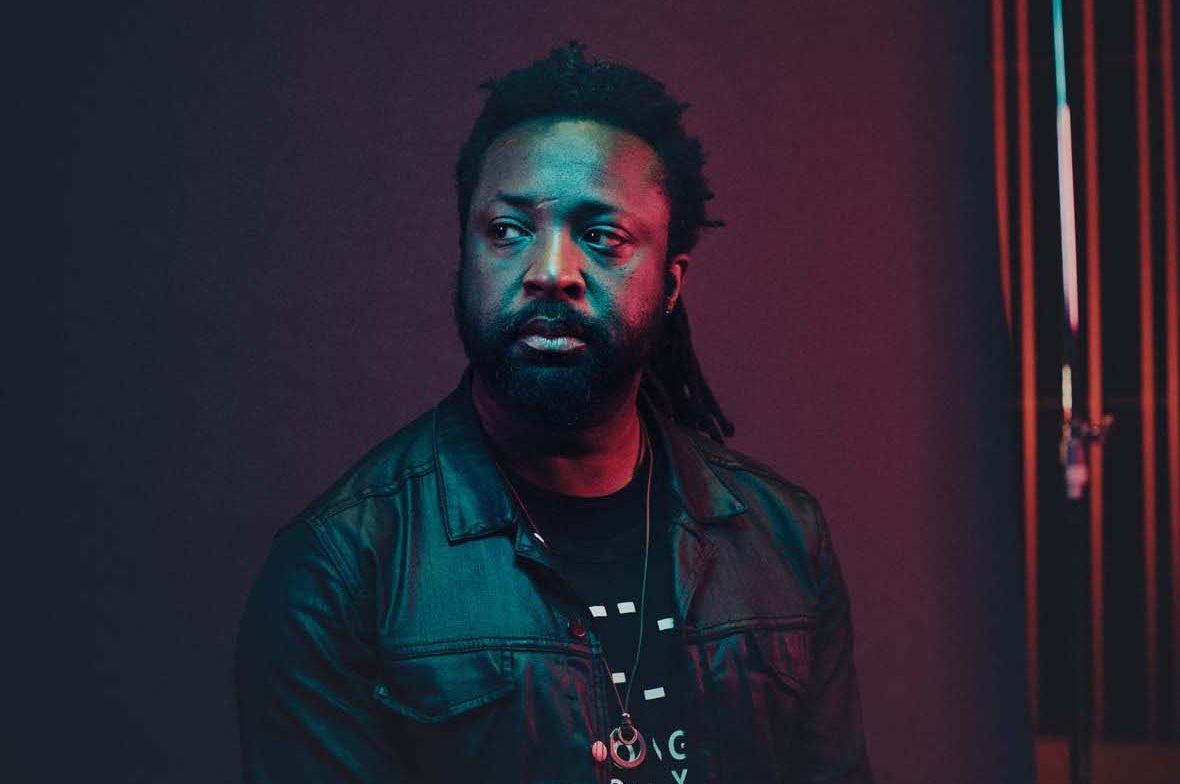
Photo by Nate Ryan
Editor’s note: Shortly after we went to press, it was announced that Marlon James’ new book, Black Leopard, Red Wolf, could become a movie, with Black Panther actor Michael B. Jordan at the helm.
Marlon James has a lot of books in his office at Macalester College in St. Paul—like, enough to fill the bed of a pickup truck. (Most academics do.) Just as indicative of the mind at work here are the bold, screen-printed music posters and stylish furniture. “We shapeshift, we code switch, we role play,” James says during a conversation on the very last day of the fall semester. “We are considered different things to different people.”
Jamaican-born James has left different marks in different circles during his decade-plus in the Twin Cities. An internationally acclaimed novelist, he won the prestigious Man Booker Prize in 2015 for his third novel, A Brief History of Seven Killings—joining past winners Life of Pi and The English Patient. He’s also a refreshing voice on social media (read his Facebook essay, “Smaller, and Smaller, and Smaller.”). As well as an English professor, he’s Macalester’s first writer-in-residence.
After three books exploring Jamaica’s gritty history, James has created a mythical universe for a new book series, the Dark Star Trilogy, which he has called an “African Game of Thrones.” As in many fantasy adventure stories throughout history, shapeshifting plays a role in Black Leopard, Red Wolf, the series’ first book, released February 5. The story is sensual, lyrical, violent, and gripping—and, James says, inspired by mythology from many traditions worldwide.

Where did you write Black Leopard, Red Wolf?
I actually got an office two miles from my house [in Minneapolis]. That’s where I wrote pretty much all of it. It’s a small room with nothing but books and story ideas on Post-It notes stuck up all over the wall. Pictures of African folklore: people, mountains, buildings, and history. I just hunkered down to write and opened the windows so I could hear traffic, because the very best African cities are also the noisiest. The previous book [A Brief History of Seven Killings] I wrote in nearly every cafe. If there was a cafe in Minneapolis, I probably wrote in there. Quite a few in St. Paul, too. I couldn’t do that with this book. It’s one thing to write a novel like Brief History, because a lot of it was drawing from stuff I know and stuff that’s easily available. With this, I’m inventing stuff. It’s not as easy as typing in “CIA directives in 1978”—I can just go online for that. Dragons, not so much. I needed a space surrounded by things that would keep me in that frame of mind. Most people assume that [with] the last book I wrote to tons of reggae, when it was actually Björk. With this, I was listening to lots of Can, Stereolab, and Miles Davis.
How much of this story was based on past myths and how much was pure invention?
Everywhere in the world has a rich mythology. Most of the myths are actual, and a lot of the creatures I didn’t invent—I found them. The cannibals with horns were here. A lot of them were part of African folklore. There’s this reservoir of folklore and history and ideas and heroes and villains and mad kings and monsters and dragons. I wanted to have fun, really. I wanted to use that rich reservoir as something to pull from. It’s a pretty conservative novel, constant violence aside. It’s the plot that’s conjecture. The only time I start to divert from conventional wisdom in the time [several hundred years ago] is things like female circumcision, which is not judged favorably in the book. The world is actually quite real. A lot of people would read it as me trying to score points for inclusion or intersectionality or tolerance by having a gay character. No, that’s the oldest trope in the book there. Discovering what certain societies have lost—that was surprising. I did think, “I’m going to introduce this.” Naw, been there, done that. I doubt that African readers will read this the way Western readers do. For one, it won’t be as magical to them. If they’re old enough, a lot of the concepts I’m talking about are nothing new.
Shapeshifting is used to great effect in this novel.
The big discovery when I was writing this book was that the shapeshifters in the African myths tend to be the cats—not the dogs. There’s no werewolf, but there’s a wereleopard and a werelion. It makes sense that it’s the great cats because these are the most powerful creatures in the land. At the very least, they’re connected to gods. Shapeshifting also, in its way, challenges gender norms and these rigid identities. I can’t have the big superhero with big muscles who is a force for right and loves his mama and is super macho. Everything is fluid, nothing is a given. That was really interesting, but also really scary to write. I’m still a product of this society. I’m still locked in rules and rigid things and identities, and so on. To throw all of that out to write this book, I was rejecting all of the fantasy [stories] I know and love. Fantasy is great, but it is a conservative, even Calvinist, genre historically: Virtue will be rewarded, and all that.
Did the Black Panther movie influence this novel at all?
No, they were pretty separate. I started researching this in 2015, and I knew I didn’t want superheroes or anything like that. One, they’re hard to write in prose. I also knew I wasn’t trying to write a contemporary story. I like my sword-and-sorcerer epics. I would rather watch even bad ones. Netflix has a bunch of them and they’re horrendous, and I’ve seen all of them. The Lord of the Rings films are a big, big thing for me. It’s still an itch that doesn’t get scratched much.

Photo by Nate Ryan
How much have you explored writing for a young adult audience?
When I was younger, there was always that book for adults that you’d steal. I would love to have written that book. It’s not written for young adults, but it’s what they steal. That’s part of the young adult reading tradition. Lord of the Flies, or books like that. Y.A. is a genre I have huge respect for. I can see extended versions of this book going in that direction. So far, not yet.
In your college courses, are you still teaching students forms like the novel, or has it become more about “content” storytelling?
I’m all for the blurring of genres, but I’m suspicious of doing that under the concept of “content.” There is a certain kind of blandness that can happen. There’s much a poem can learn from a novel and vice versa, but they’re independent forms. I still think the distinctions are very important. You’ve got to know the rules before you break them. I’m teaching undergrads, so the conventions become even more important. You want to be fully aware of the art you’re violating.
What is your approach to teaching nonfiction writing in 2019?
There’s so much preparation you have to do to write nonfiction. Even more so than fiction. A memoir reflection is still just one person’s opinion. If you’re going to reach a certain kind of authority, then you need more than that. I don’t care that it happened to you; go research it. When my students come to me, I sometimes get two kinds. One, who think their life is so privileged and dull they have nothing interesting to write about, or, “My life is so riddled with trauma and I’m dealing with it, that I can’t bear to talk about it.” The thing about both of those responses is that they sound different, but they’re both rooted in shame, and the conclusion is, “I am not worthy of putting something down on this paper.” They have to learn to move from self-conceit or self-hatred to self-curiosity.
Your “Smaller and Smaller and Smaller.” Facebook essay started a lot of conversations after the Philando Castile shooting. What’s next?
The next chapter of that conversation is conversation. I suspect that no one is going to talk about it until there’s another shooting. We need to talk about it before then. Our panels, our town halls, or whatever. Stuff needs to get talked about before somebody else gets shot. That’s one thing. That also involves talking to the police. I looked at how our segregation here plays out at a very extreme level, but it also plays out on a door-to-door level, too. One thing that happens in Minneapolis, particularly with people of color—a lot of people move here because opportunities are great. But they don’t stay. At some point, it’s not a glass ceiling, it’s a friend ceiling.
Aside from trying to break into his house [a story told in a Late Night with Seth Meyers appearance], do you have any other Prince stories?
I don’t think I have any other ones. My high school yearbook says my ambition is to work for Prince. Actually, I never met him. I thought, “I’m here, he’s here, it’s bound to happen.” It didn’t. One of my big all-time regrets. Prince was the artist. It was strange when he died. I cried when I heard Prince died, but I didn’t even cry when I heard my dad died.








